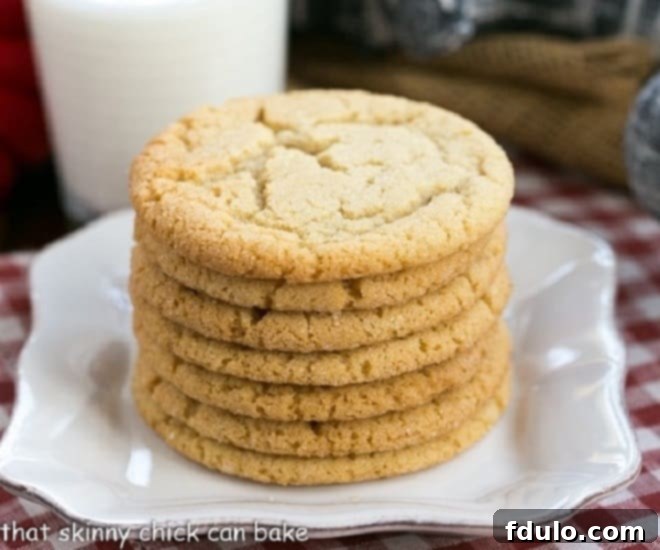Welcome to the world of truly exceptional baking, where simple ingredients transform into something magical. These soft, wonderfully caramelly Chewy Butterscotch Cookies are more than just a recipe; they are a tradition. Every Christmas, these delightful cookies are the stars of the goodie boxes I lovingly prepare and share with friends and neighbors. Prepare to fall head over heels for these irresistible, crackled delights, crafted with minimal fuss and maximum flavor. They are a cherished family favorite, guaranteed to become a staple in your own home baking repertoire.
Making these homemade butterscotch cookies is incredibly easy, yet the results are profoundly satisfying, appealing to virtually everyone who takes a bite. Butterscotch, with its deep, rich, and mellow sweetness, offers a perfect alternative for those who might not prefer chocolate (gasp!), nuts, or mint in their treats. The process is elegantly simple: just roll the sweet, buttery dough balls in sugar before baking. This straightforward step yields cookies that are not only addictive in flavor but also boast an appealingly crisp exterior that gives way to a delightfully chewy interior. What truly elevates this easy sugar cookie recipe is the thoughtful inclusion of brown sugar, which imparts a delicious depth of flavor and a signature caramel-like warmth that defines true butterscotch.
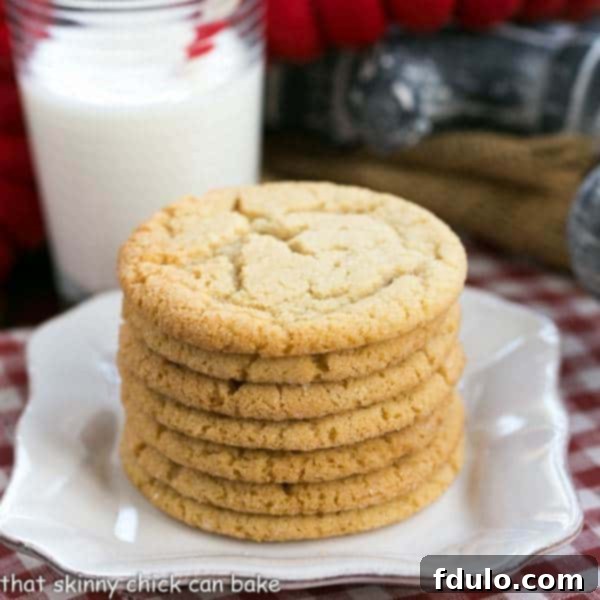
Why You Must Make These Chewy Butterscotch Cookies
There are countless reasons why these Chewy Butterscotch Cookies deserve a prime spot in your baking collection, but here are the highlights:
- Unforgettable Flavor and Texture: These cookies offer a truly melt-in-your-mouth experience, imbued with exquisite caramel undertones that dance on your palate. Unlike artificial butterscotch, the flavor here is authentic, rich, and deeply satisfying, providing a gourmet touch to a simple cookie.
- Universal Appeal: Sugar cookies, in their many forms, are almost universally loved. This particular recipe takes that adoration to another level with its unique butterscotch profile, making it a crowd-pleaser for all ages and preferences. Whether you’re serving them at a party or just enjoying them with a cup of coffee, they are always a hit.
- Versatile for Every Occasion: From a comforting after-school snack to a delightful addition to lunch boxes, these homemade butterscotch cookies fit perfectly into any moment. I personally cherish them as a staple for my annual Christmas baking, their warm, inviting aroma filling the home with holiday cheer. Their versatility makes them ideal for various celebrations throughout the year.
- A Touch of Nostalgia: For many, the taste of butterscotch evokes a sense of nostalgia, bringing back fond memories of childhood treats. These cookies capture that classic, comforting flavor, but in a more refined and homemade form that truly satisfies.
The story behind these particular butterscotch cookie recipe gems adds another layer to their charm. My father-in-law, a man of discerning taste, would often seek out exceptional chewy butterscotch cookies at his local farmers’ market. He was so captivated by these delightful treats that he embarked on a mission to secure the recipe. After many pleasant conversations and a persistent charm, he finally managed to obtain the treasured formula from the talented baker herself.
We shared a mutual appreciation for many culinary delights, ranging from comforting apple desserts to savory smoked fish, crunchy nuts, and rich caramel desserts. Though I’ve been told he was quite particular, only eating a couple of vegetables when he married my mother-in-law, it’s hard to say if he or his son, my husband, possessed a more persnickety palate. What is certain, however, is that both of these notoriously picky eaters wholeheartedly agreed: these Brown Sugar Cookies were nothing short of phenomenal. This endorsement alone speaks volumes about their exceptional quality and irresistible taste.
How to Make the Best Chewy Butterscotch Cookies
The secret to the genuine “butterscotch” flavor in these cookies lies not in artificial chips, but in the harmonious blend of butter and brown sugar. This combination naturally creates those beautiful, deep caramel undertones that are the hallmark of true butterscotch.
- Room Temperature Ingredients are Key: For seamless incorporation and a perfectly uniform dough, always ensure your butter and egg are at room temperature. This allows them to cream together effortlessly with the sugars, creating a smooth and emulsified base.
- PRO-Tip: The Magic of Cream of Tartar: A small but significant addition of cream of tartar is what gives these cookies their distinctive, lovely crackled appearance. This white, acidic powder works by providing a touch of acid to the batter, which aids in leavening and contributes to the cookie’s texture. I also swear by it for stabilizing egg whites in my meringue cookies, ensuring they hold their shape beautifully.
- Butter vs. Margarine: For the most authentic and richest butterscotch flavor, always opt for real butter. Margarine simply cannot replicate the complex taste and creamy texture that butter provides, which is crucial for these cookies.
- Understanding Brown Sugar: Brown sugar is essentially white granulated sugar with molasses added, which gives it its characteristic color, moistness, and depth of flavor. If you desire an even richer, more intensely flavored cookie, feel free to use dark brown sugar. Just note that this will result in a slightly darker finished cookie.
- PRO-Tip: Brown Sugar for Chewiness: One of the key benefits of using brown sugar is the extra moisture it brings to the dough. This additional moisture is precisely what contributes to the incredibly chewy texture of these cookies. These Brown Sugar Butterscotch Cookies are celebrated for their rich flavor and wonderfully satisfying chew!
- The Sweet Coating: Rolling the dough balls in granulated sugar before baking serves a dual purpose. It not only adds an extra layer of sweetness but also creates a delicate, crisp crust that provides a delightful textural contrast with every first nibble.
- Simplicity in Baking: This recipe is refreshingly straightforward. While forming the dough balls and rolling them in sugar might take a little time, the process is therapeutic and enjoyable, making it a perfect baking project for any skill level.
- Storage and Longevity: These cookies store exceptionally well. Keep them in an airtight container at room temperature for approximately 3-4 days to maintain their freshness and chewiness. For longer enjoyment, they also freeze beautifully for up to 3 months, ready to be thawed and savored whenever a craving strikes.
- Perfect for Any Occasion: This butterscotch cookie recipe is incredibly versatile. While they are a staple in my holiday gift boxes for neighbors, they are equally ideal for welcoming new residents, offering comfort to a family celebrating a new baby or coping with a loss, participating in a festive cookie exchange, enhancing an afternoon tea, or simply serving as a delightful after-school snack.
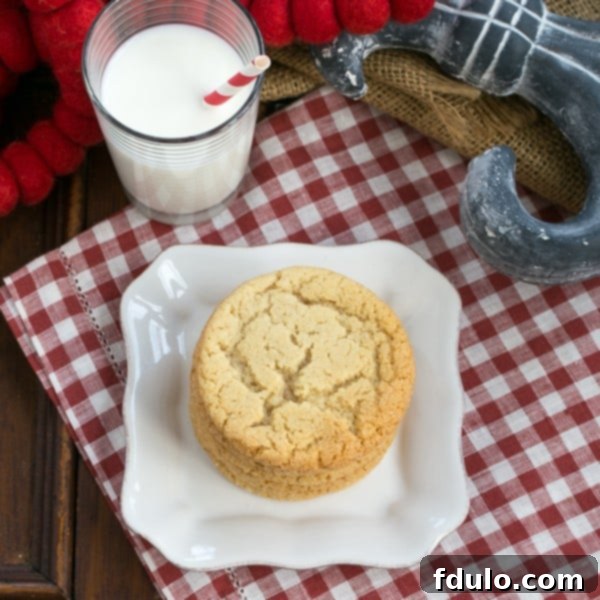
Expert Tips for Perfecting Your Butterscotch Cookies
Achieving consistently perfect cookies requires a few insider tricks. Here are some expert tips to ensure your Chewy Butterscotch Cookies turn out flawless every time:
- PRO-Tip: Uniformity with a Cookie Scoop: For beautifully even-sized cookies that bake uniformly, I highly recommend using a Medium Cookie Scoop. Consistent size isn’t just for aesthetics; it ensures every cookie bakes at the same rate, preventing some from being overdone while others are underbaked.
- Size Matters (or Doesn’t): My preferred dough balls are approximately the size of a walnut, which results in rather large, satisfying cookies. And honestly, no one around here has ever complained about a bigger cookie! If you appreciate a generous treat, stick to this size.
- Adjusting for Smaller Bites: Should you prefer daintier cookies, a Small Cookie Scoop works perfectly. Remember to reduce the baking time accordingly when making smaller cookies, as they will cook faster. There’s no need to flatten these dough balls before baking; they will naturally spread to a beautiful, crackled disk.
- Perfectly Round Dough Balls: After scooping out the dough, take a moment to roll the dough ball gently between your palms. This simple step ensures they are perfectly round, which contributes to a more appealing final shape and even spreading during baking.
- Post-Bake Perfection: When your cookies emerge from the oven, still warm and pliable, you have a brief window to correct any minor imperfections. If a cookie isn’t perfectly round, gently use your spatula to tap the edges into shape. This must be done quickly while the cookies are still hot and soft.
- Timing is Everything: Once the cookies cool for just a couple of minutes, they lose their pliability and set. Don’t forget to grab your hot pad and make any alterations quickly and efficiently to achieve that ideal shape.
- Baking Surface: For easy removal and effortless cleanup, always bake your cookies on a quarter sheet pan lined with parchment paper. This prevents sticking, ensures even baking, and makes transferring the warm cookies a breeze.
- PRO-Tip: Slightly Underbake for Chewy Excellence: The ultimate secret to achieving that coveted chewy texture is to slightly underbake your cookies. Remove them from the oven when the edges are just set and lightly golden, but the centers still look a little soft. They will continue to cook slightly on the hot pan after removal, resulting in a perfectly chewy interior once cooled.
Ingredient Notes for Irresistible Butterscotch Cookies
Each ingredient plays a vital role in creating these incredible Chewy Butterscotch Cookies. Choosing quality ingredients and preparing them correctly makes all the difference.
- Kitchen Staples: These include essential items like granulated sugar (both for the dough and for coating), brown sugar, all-purpose flour, baking soda, and a pinch of salt. Ensure your flour is fresh and accurately measured.
- Butter: Use unsalted butter, softened to room temperature, for easy and smooth blending with the sugars. If you only have salted butter, simply reduce the added salt in the recipe by about ¼ teaspoon. Room temperature butter creams beautifully, incorporating air for a lighter texture.
- Egg: Like butter, your egg should also be at room temperature. This helps it emulsify better with the other ingredients, leading to a more cohesive and tender dough.
- Vanilla Extract: Always opt for real vanilla extract. Avoid artificially flavored vanilla, as it can impart an unpleasant aftertaste. A high-quality extract, such as the Nielsen-Massey Brand, adds a beautiful aromatic depth that complements the butterscotch flavor perfectly.
- Cream of Tartar: This often-overlooked ingredient is crucial for the signature crackled surface of these cookies. It acts as an acid, working with the baking soda to create a gentle rise and a delightful textural contrast. Don’t skip it if you want those pretty cracks!
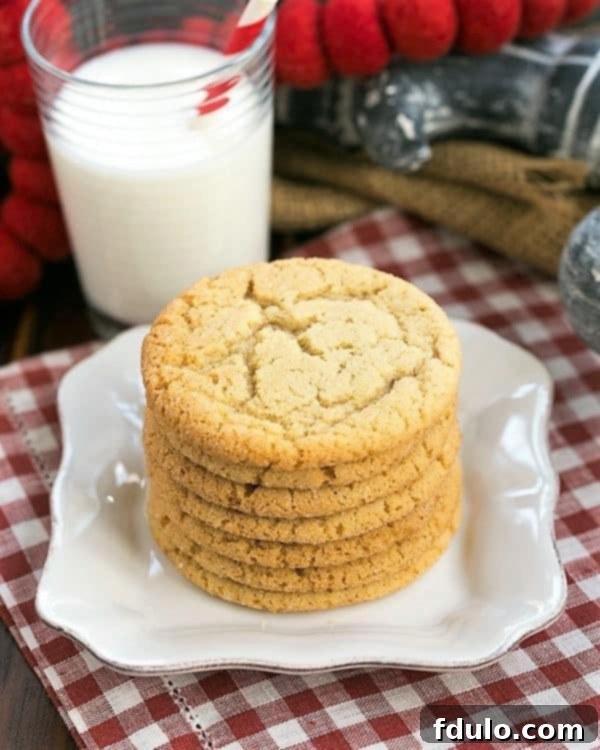
Frequently Asked Questions About Butterscotch
Curious about butterscotch? Here are some common questions and detailed answers to deepen your appreciation for this beloved flavor.
Butterscotch is a classic confectionary flavor primarily derived from the rich combination of brown sugar and butter. It’s often compared to caramel, but there’s a key distinction: caramel is traditionally made with white, granulated sugar, while butterscotch exclusively uses brown sugar. This fundamental difference gives butterscotch its unique, deeper, and often more complex flavor profile with distinct molasses notes. Toffee, on the other hand, is a different beast entirely; it’s cooked to a much higher temperature, reaching a “hard crack” candy stage, resulting in a brittle, hard candy, unlike the softer, chewy consistency of butterscotch and caramels. The brown sugar in butterscotch contributes to its characteristic chewiness and a more nuanced, less overtly sweet taste than some caramels.
The delightful flavor of butterscotch has a rich history that can be traced back to Yorkshire, England. It was here, in the early 19th century, specifically around 1817, that a pioneering candymaker named Samuel Parkinson is credited with its invention. Parkinson’s establishment in Doncaster, Yorkshire, became famous for its “Doncaster Butterscotch,” a sweet treat that quickly gained popularity, even reportedly being favored by the British Royal Family. His original recipe likely featured the characteristic ingredients of brown sugar and butter, establishing the foundation for the butterscotch we know and love today.
The etymology of “butterscotch” is a subject of ongoing debate among food historians, with no single definitive consensus. One popular theory suggests that the “scotch” in butterscotch might be linked to the country of Scotland, perhaps indicating a geographical origin or a style of candy popular there. However, another compelling theory proposes that “scotch” is a derivation or shortening of the word “scorch.” This idea stems from the traditional method of making butterscotch candy, which often involves cooking the butter and brown sugar mixture until it just begins to scorch or brown at the edges, contributing to its characteristic rich flavor and color. Both theories offer plausible explanations, adding a layer of mystery to this beloved treat’s name.
You May Also Like: More Irresistible Cookie Recipes
If you’ve fallen in love with these Chewy Butterscotch Cookies, you’ll surely enjoy exploring more delectable treats. Here are some other recipes, both mine and from fellow bakers, that you might like:
- Butterscotch Peanut Butter Corn Flake Clusters from Crazy for Crust – a no-bake, irresistible treat!
- Big Dipper Oatmeal Butterscotch Cookies – a chewy, hearty classic with a butterscotch twist.
- Butterscotch Blondies with White Chocolate Chips – for those who love their butterscotch in bar form.
- Classic Vanilla Spritz Cookies – delicate and buttery, perfect for holiday platters.
- Best Meringue Cookies – light, airy, and wonderfully crisp.
- White Chocolate Macadamia Nut Cookies – a beloved combination of creamy and crunchy.
- Discover more delightful Cookie Recipes for every craving and occasion.
- Explore a wide array of Best Dessert Recipes to satisfy your sweet tooth.
Stay in touch through social media @ Instagram, Facebook, and Pinterest. Don’t forget to tag me when you try one of my recipes! And if you love the results, please give it a 5-star rating in the recipe card below.
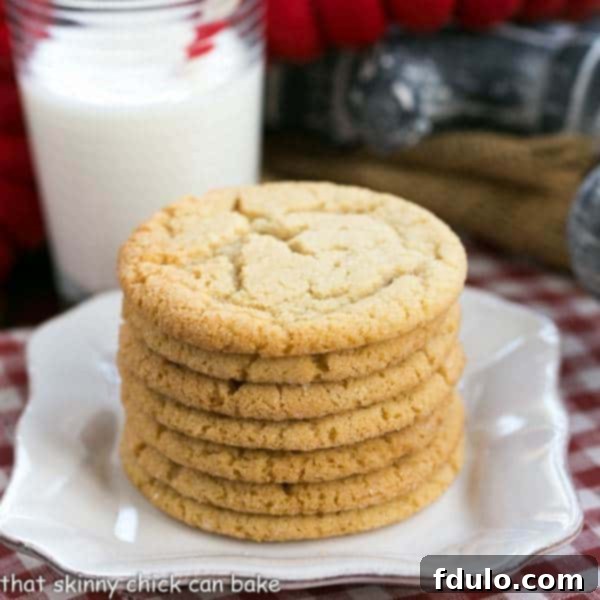
Butterscotch Cookies Recipe
20 minutes
10 minutes
30 minutes
36 cookies
These incredibly soft and caramelly Butterscotch Cookies are a cherished family favorite, making them a perfect addition to holiday goodie boxes or for any occasion.
Ingredients
- 1 cup granulated sugar
- 1 cup light brown sugar, packed
- 1 cup unsalted butter (two sticks), softened
- 1 large egg, at room temperature
- 2 teaspoons pure vanilla extract
- 2 ½ cups all-purpose flour
- 2 teaspoons baking soda
- ¼ teaspoon salt
- 2 teaspoons cream of tartar
- Extra granulated sugar, for coating dough balls
Instructions
- Preheat your oven to 325ºF (160ºC). Line baking sheets with parchment paper.
- In a large bowl, using an electric mixer, cream together the softened butter and both sugars until light and fluffy.
- Beat in the room temperature egg and vanilla extract until well combined.
- In a separate medium bowl, whisk together the flour, baking soda, salt, and cream of tartar. Gradually add the dry ingredients to the wet ingredients, mixing on low speed until just incorporated and a soft dough forms. Do not overmix.
- Scoop rounded teaspoons of dough (or use a medium cookie scoop). Roll each dough ball gently between your palms to ensure it’s round, then roll thoroughly in the extra granulated sugar to coat all sides.
- Place the coated dough balls on the prepared baking sheets, ensuring they are about 2 inches apart to allow for spreading.
- Bake for 9-10 minutes. If you opt for slightly larger cookies (walnut-sized), they may require up to 12-15 minutes. For the ultimate chewy texture, aim to slightly underbake them; the edges should be lightly golden and set, but the centers should still appear soft.
- Remove from the oven and let cool on the baking sheet for 2-3 minutes before transferring them to a wire rack to cool completely. This allows them to set further and maintain their chewy texture.
Recommended Products
As an Amazon Associate and member of other affiliate programs, I earn from qualifying purchases.
- Reynolds Cookie Baking Sheets Non-Stick Parchment Paper, 25 Sheet, 4 Count
- USA Pan Bakeware Half Sheet Pan, Warp Resistant Nonstick Baking Pan, Made in the USA from Aluminized Steel – 1050HS
- USA Pan 1603CR X-Large Bakeable Nonstick Cooling Rack, 19.75 x 13.625-Inches
Nutrition Information:
Yield:
36
Serving Size:
1 cookie
Amount Per Serving:
Calories: 121Total Fat: 5gSaturated Fat: 3gTrans Fat: 0gUnsaturated Fat: 2gCholesterol: 19mgSodium: 129mgCarbohydrates: 17gFiber: 0gSugar: 11gProtein: 1g
HOW MUCH DID YOU LOVE THIS RECIPE?
Please leave a comment on the blog or share a photo on Pinterest
